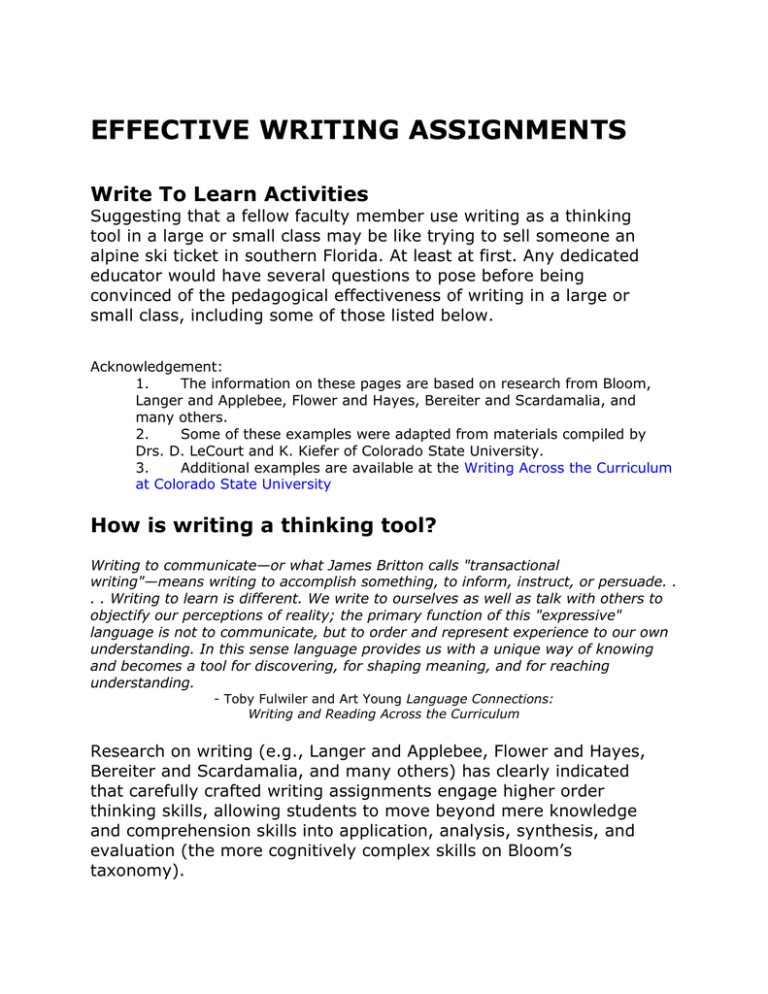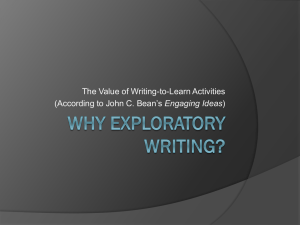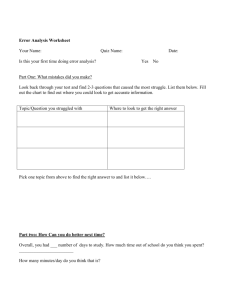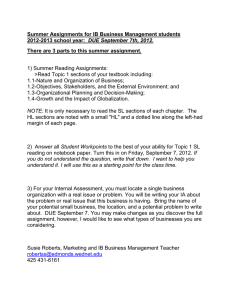EFFECTIVE WRITING ASSIGNMENTS Write To Learn Activities
advertisement

EFFECTIVE WRITING ASSIGNMENTS Write To Learn Activities Suggesting that a fellow faculty member use writing as a thinking tool in a large or small class may be like trying to sell someone an alpine ski ticket in southern Florida. At least at first. Any dedicated educator would have several questions to pose before being convinced of the pedagogical effectiveness of writing in a large or small class, including some of those listed below. Acknowledgement: 1. The information on these pages are based on research from Bloom, Langer and Applebee, Flower and Hayes, Bereiter and Scardamalia, and many others. 2. Some of these examples were adapted from materials compiled by Drs. D. LeCourt and K. Kiefer of Colorado State University. 3. Additional examples are available at the Writing Across the Curriculum at Colorado State University How is writing a thinking tool? Writing to communicate—or what James Britton calls "transactional writing"—means writing to accomplish something, to inform, instruct, or persuade. . . . Writing to learn is different. We write to ourselves as well as talk with others to objectify our perceptions of reality; the primary function of this "expressive" language is not to communicate, but to order and represent experience to our own understanding. In this sense language provides us with a unique way of knowing and becomes a tool for discovering, for shaping meaning, and for reaching understanding. - Toby Fulwiler and Art Young Language Connections: Writing and Reading Across the Curriculum Research on writing (e.g., Langer and Applebee, Flower and Hayes, Bereiter and Scardamalia, and many others) has clearly indicated that carefully crafted writing assignments engage higher order thinking skills, allowing students to move beyond mere knowledge and comprehension skills into application, analysis, synthesis, and evaluation (the more cognitively complex skills on Bloom’s taxonomy). How the heck am I supposed to grade all those papers? This is an understandable concern, even with small classes. As an instructor, you do not have to use writing to assess written products; you can also use writing to assess learning processes, to allow students to explore what they know and don’t know as a way of deepening their understanding of the concepts you are teaching. And the best part: you don’t have to grade their process writing; sometimes, you don’t even have to collect it. Generally, writing-to-learn (WTL) activities are short, impromptu or otherwise informal writing tasks that help students think through key concepts or ideas presented in a course. Often, these writing tasks are limited to less than five minutes of class time or are assigned as brief, out-of-class assignments. Most instructors do not grade these, but read and comment on some—but generally not all—of them. Many options exist. You can pick up a single sheet of paper and comment briefly on students' grasp of a reading assignment or key concepts, or pick up WTL material from five-ten students every day or every other day. Don't read every word, but skim quickly to identify the task students might need help with. Use different colored pens or highlighters to note points in selected entries. One color means "good idea," one means "consider pursuing this idea as a paper topic," another means "come back to this idea again and explore it in more detail," and so on. While students are writing at the beginning and end of class, walk around the room and read over shoulders. This technique is especially easy if you have students writing on computers. Stop to talk to or jot a note on the writing of 3-4 students. If students don't like having you read over shoulders, ask them to select a few recent WTL activities and put those to one side for you to collect and read quickly. Grading WTL Options: • Ask students to select their best or most provocative WTL writing for you to review. • Ask students to share WTL activities with a classmate, small groups, or the whole class. • Ask students to send the WTL writing that contains questions about course material to you over e-mail. • Ask students to post provocative questions or summary/analysis of readings on an electronic bulletin board or Web forum for class comment. Logistical Tips: Have students use loose-leaf paper, not a spiral bound notebook. Students might misplace some of their writing, but teachers can much more easily pick up single pages to review. Also, get students into the writing habit by starting or ending many classes with a WTL activity. Call occasionally on some of the brighter, more introverted students—they often relish these activities because they have more time to compose their thoughts than with oral questions, and the activity provides them a script to read from. This sounds too good to be true. How do I get away with assigning writing that I never grade? While the prospect of not grading—or not even collecting—writing assignments may go seriously against our best teacherly instincts, the benefits to be gained from writing-as-a-mode-of-learning are many. The fact that we don't have time to grade papers continuously should not interfere with students' potential to learn through writing. The following suggestions on how to achieve this are possibilities, so feel free to modify them to suit your own (and your students') needs. Indeed, the success or failure of these—or any—writing assignments depends on how well suited and how responsive they are to the content and requirements of the course and the abilities or levels of the students. In-Class Writing Activities Most of the following activities take five to fifteen minutes of class time. You can collect and read these assignments or not as you see fit. Opening: At the beginning of class, pose a question related to a topic you have planned for the class to discuss. For example, ask the class to write on the following question: "How would you evaluate the evidence used to support article X vs. the evidence to support article Y?" or "How would you describe the tone of essay X?" The five-minute writing will serve as a warm-up and provoke students to do some thinking, even if they only discover that they don't quite know what "tone" means. You can develop the discussion from there. Closing: At the end of class, ask a question that can provide a starting place for the next class. Examples: • "What did you learn today about the potential applications of the laws of thermodynamics?" • "What questions were left unanswered for you in our discussion of the kinds of tissue in the human body?" Study Questions: Ask students to write their own study questions, "exam" questions, or word problems on the material being covered and to work together to answer them. Anticipants: Give students the beginning or the end of a report, paragraph, story, case study, or problem, and then give them fifteen minutes to write what follows or leads up to the statement. This brief exercise, which can be used for in-class work, helps students do the kind of goal-directed predicting and planning common to skilled writers and thinkers. Class Minutes: Assign a class scribe for the day who will be responsible for summarizing class discussion, lecture, or activities during the first five minutes of the next day's class. Or have two people serve as independent scribes; invite the class to discuss the differences in the minutes they produce. Question Box: Like a suggestion box, a question box has a slot where people can anonymously insert ideas. In this case, though, students insert a question or two about course material, which is particularly useful just prior to an exam. Instructors look for patterns of recurring questions to guide their midterm and final review sessions; these patterns let us know what exactly a majority of students do not yet understand. Concept Metaphors: Ask students to think through a concept by creating a metaphor, building a model, or creating a definition for it. For example, in a dentistry class, students may create a metaphor for "teeth" (teeth are crystal castles), build a conceptual model f or the structures of caries, and write a definition of "decay." Students may use the metaphor to build a theory about their experience. Interruptions: Ask students to stop and write when you feel they may need a moment to focus attention, assimilate information, or articulate a question. Use these short writings to refocus class discussion or attention. Short-Answer Quizzes: Ask students to write a short answer to a question from their reading or class discussion. You may ask the students to explain a process, summarize a point, define a term, or apply a concept. You may want to have some students read their short answers aloud in class. How-to Papers: Have two groups of students conduct two different experiments. Then, in writing, have them explain how someone who had never done the experiment would conduct it. Then have the writing group remain silent as the other group tries to follow their step-by-step instructions to carry out the experiment. (Be careful in chemistry lab!) Switch groups and have the next group follow the other group’s instructions. Then have both groups rewrite their instructions so they are more reader-friendly. Out-of-Class Writing Activities Abstract: Depending on the level of detail that might be useful for each assignment, have students write out a paragraph or a page of summary for each assigned reading. When collected in a reading journal or learning log, these summaries help students understand readings more fully when they are first assigned and remember them clearly for later tests or synthesis assignments. Annotations: Unlike the summary that attempts an objective rendering of the key points in a reading, an annotation typically asks students to note key ideas and briefly evaluate strengths and weaknesses in an article. In particular, annotations often ask students to note the purpose and scope of a reading and to relate the reading to a particular course project. Response Papers: Still another type of writing to learn that builds on assigned readings is the response paper. Unlike the summary, the response paper specifically asks students to react to assigned readings. Students might write responses that analyze specified features of a reading (the quality of data, the focus of research reported, the validity of research design, the effectiveness of logical argument). Or they might write counter-arguments. To extend these response papers (which can be any length the instructor sets), consider combining them into another assignment--a position paper or a research-based writing assignment. Synthesis Papers: A more complex response to assigned readings is the synthesis paper. Rather than summarizing or responding to a single reading assignment, the synthesis paper asks students to work with several readings and to draw commonalties out of those reading s. Particularly when individual readings over-simplify a topic or perspectives on a question in your course, the synthesis paper guarantees that students grapple with the complexity of issues and ideas.Like other writing-to-learn tasks, the synthesis paper can be shorter and less formal, or you can assign it at or near the end of a sequence leading to a more formal paper. The Problem Statement: Teachers usually set up the problems and ask students to provide solutions. Two alternatives to this standard procedure will give students practice with both framing and solving problems. After you introduce a new concept in your course, ask students to write out a theoretical or practical problem that the concept might help to solve. Students can exchange these problems and write out solutions, thus ensuring that they understand the concept clearly and fully. Another version of this exercise is to have students write a problem statement that is passed on to another student whose job it is to answer it. Such peer answers are especially useful in large classes. Analyzing the Process: Sometimes students are baffled by the explanations teachers give of how things happen because teachers move too quickly or easily through the process analysis. A quick run-through of an equation is often just not enough for students struggling to l earn new material. A more useful approach to process analysis—from the learners' point of view—is to trace in writing the steps required to complete the process or to capture the thinking that leads from one step to the next. Students can either write while or after they complete each problem. Particularly when students get stuck in the middle of a problem, writing down why they completed the steps they did will usually help someone else (a classmate, tutor, or teacher) see why the student experienced a glitch in problem-solving. Similarly, teachers can look over the process analyses to see if students have misapplied fundamental principles or if they are making simple mistakes. In effect, students can concentrate on problem solving rather than on minor details, and they can move from simple procedures followed by rote into a deeper understanding of why they are solving problems appropriately. Compacts: Have students write a two or three-page essay on a key course concept, process, or application. You might want to assign different groups different topics, possibly according to last names (e.g., A-E, F-J, K-O, etc.). The day they bring their essays to class, have them condense the three-page essay into a one-page essay, an act that underscores the importance of writing concisely and precisely. Then have the students in each group read each others’ one-page essays and write a group paper that combines the best of everyone’s ideas but does not exceed one page. You can collect these and quickly scan over them to gauge students’ level of understanding. In the next class, put these group papers on an overhead transparency and let the class comment on their effectiveness, both in terms of the writing and the content. This activity gives students practice in revision, synthesis, and peer review and reinforces key course concepts. Notebook or Journal Writing Requiring students to keep a notebook, journal, or log and to write in it informally on a regular basis is an excellent way to assign widely diverse kinds of writing activities in a casual way. Journals are highly adaptable and versatile: you can have students write in them regularly or sporadically, in class and out of class. In addition to the assignments below, think about using the journals for any or all of the in-class tasks described above, or perhaps about assigning weekly out-of-class questions from the class textbook. You can collect the notebooks periodically to respond to them. As with all the Writing-to-Learn activities, don't feel that you must "grade" these notebooks, but do respond naturally to what students say and suggest ways they can be even more insightful. Alternatively, don't make comments at all--just collect them and note briefly how complete the entries are or what types of patterns of ideas emerge in a number of entries. Below are several particularly effective ways to use journals. Reading Logs: Ask students to keep a notebook designed to help them understand their reading assignments better and to demonstrate to them that critical reading is an active process. First, introduce them to the "Survey, Question, Read, Recite, Review, Write" method for improving reading habits and ask them to practice it regularly in their reading journals. As they survey the reading assignment, they should note large headings, the first sentence of each paragraph, and the first and last paragraphs of the assigned text. At this point, they should record in their notebook answers to the following questions: 1. What is the main subject or topic of this text? 2. What do I expect the major points to be in discussing this topic? 3. What questions do I have that I hope will be answered by this text? Students then read "with a purpose", i.e., to answer their questions and to see whether hypotheses are confirmed or denied--which is what good readers do. After they have read the text and attempted to answer the questions, they should review the material, noting whether the major points and questions they identified turned out to be accurate. Finally, they should write in their notebook answers to the questions they posed. Reading Response Questions: 1. Summarize, as briefly as possible, what you have read. 2. Describe how the reading has made you feel, explaining why whenever possible. 3. What are your other responses to what you have read? 4. What has this reading made you think about? 5. What has this reading suggested you might want to write about? Ask students to keep reading notebooks, but to write "double entries" for each assigned reading. That is, have them divide in half each page in their journal lengthwise. On the right side of the notebook, they record reading notes, direct quotations, lists, and observational notes. On the left side, they write notes about those right-hand side notes-summaries, questions, revisions, comments, and personal responses. Ann Berthoff says that the double-entry format provides a way for students to "conduct that continuing audit of meaning that is at the heart of learning to read and write critically. The facing pages are in dialogue with one another." Reading and Writing Logs: Reading and writing notebooks, of course, may be used in informal ways, and students should be encouraged to use the notebook to fulfill their own purposes. For example, some might want to keep a section called "questions I don't know the answers to," while others might want to focus on personal responses to what they have read. An American history student might want to free-write in her notebook about her personal, free-associative responses to materials read about the Civil War before going on to a more traditional, analytical approach to those same materials. Observation Reports: Ask students to do a bit of field research, taking careful field notes on whatever they choose to observe: a physical object, person or animal, process, event, or phenomenon. Students can then compare these notes and question one another about what may be missing. Problem Generating: Have students generate "problems" from the reading or class discussions. Generating problems is often harder than solving them, and so this activity forces students to articulate key issues or questions. One way to do this might be to have math or physics students take a formula or theorem and create a scenario or word problem that would require using the formula. In a history class, students might write journal entries that consist simply of lists of questions from the outside reading that they would pose to the author of the piece or offer up for class discussion. Focused Questioning: Have students articulate places where they got stuck and how they solved their dilemmas, whether the problems be found in comprehending outside readings or in working on homework assignments. This strategy can also be effective in pinpointing the source of the thinker’s block; when students feel stuck, leaving the primary task and writing a journal entry about where they think the problems come from can stimulate fresh thinking.



